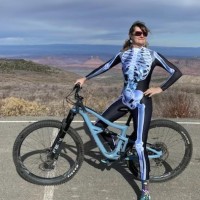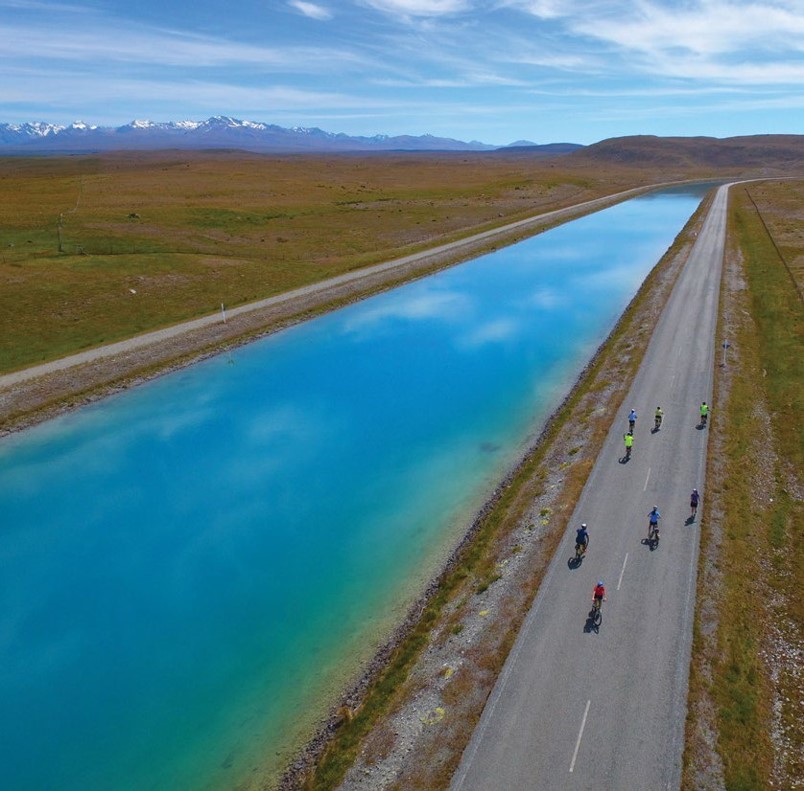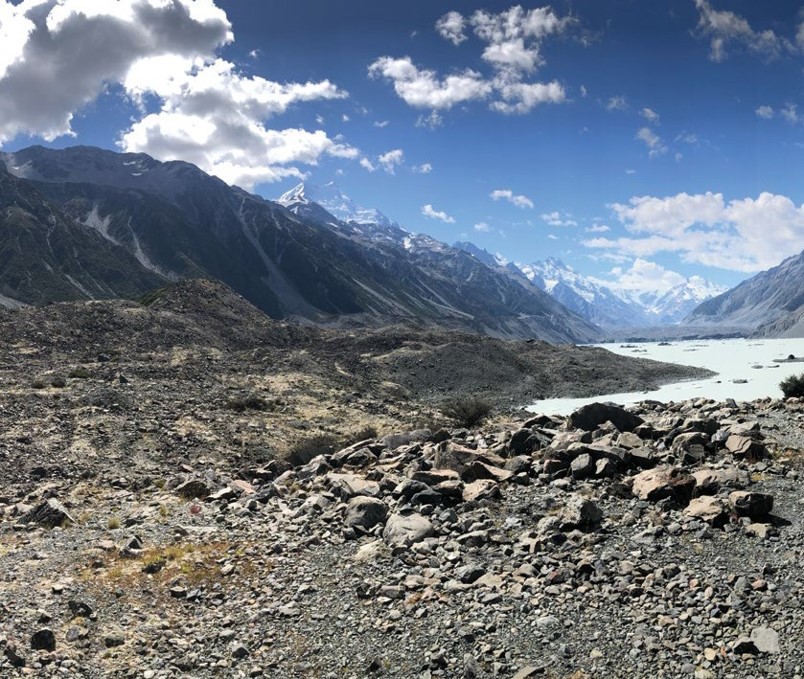American rider Maureen Gaffney's experience of the Alps 2 Ocean Cycle Trail, published in 'Adventure Cyclist' magazine.
 It looks just like northern California. Wait, now it looks more like Scotland. And an hour ago it looked like Hawaii.
It looks just like northern California. Wait, now it looks more like Scotland. And an hour ago it looked like Hawaii.
One thing you can be sure of when cycling the 195-mile Alps 2 Ocean Trail, one of New Zealand’s 23 “Great Rides,” is that you will not lack for a variety of scenery.
Coming from the depths of a Colorado Rocky Mountain winter — where the nights were considered “chilly” at 4°F, the dark was long, and an innocent five-yard walk to the mailbox could send you sprawling, located as it was amid an ice floe — Auckland, with its 73°F and sun till 9:45 pm felt impossibly magical, like I’d gone through the back of the wardrobe and here was Narnia.
New Zealand is made up of a north island and a south island. South Island, Te Waipounamu in Māori, tells itself and others that it is the “adventure island,” the place for the sporty set with its bungee jumping, glacier trekking, and skydiving, among many other pursuits. While this is absolutely true, and most of my time was indeed spent on South Island, North (Te Ika-a-Māui) is just a bit more humble regarding its treasures. The fern and redwood forests of Rotorua, just south of Auckland, are places where humans involuntarily lower their voices in reverence when enveloped by its soft green and brown hues. The spongy mosses push playfully back when touched, and the smell of sunshine on the fuzzy bark of a giant redwood tree rewires your neural pathways and finds its way into your DNA.

However, unlike Narnia, there are no lions here. Nor bears. Nor poisonous snakes. Unlike Australia where everything wants to kill you (sorry Oz, but you know it’s true), here nothing does. And if the drivers on the occasional on-road stretches of the Alps 2 Ocean (A2O) seemed to be honk-happy and a bit wild with gesticulation, those were the times I forgot to ride on the “wrong” side of the road. To add to the mind-bending task of riding on the left, the brakes are also swapped, i.e., the right brake lever is for the front and the left lever for the rear.
You know how sometimes you take out the garbage and you don’t put the bin back straight away for whatever reason (phone rang, TikTok, asteroid) and you keep throwing trash into that empty space where the bin should be? Well, turns out braking and riding on the right are sort of like that. You can chant left left left left all you want, but when the corner is tight, the gravel is loose, and you’re coming in hot, it’s right (front) brake lever and swerving to safety on the right (wrong) side of the trail faster than you can say, “Oy! The American ate ___ again.”
New Zealand has long been a destination for the sporty set, and they’ve done well building the infrastructure to support it. Starting around 2009, the New Zealand government officially launched the Great Rides of New Zealand project. Twenty-three long-distance trails from 21 to 330 kilometers (13 to 205 miles) in length spread across both North and South Islands, the Great Rides project represents a progressive partnership between business and government that seeks to encourage environmentally sustainable tourism that spurs, supports, and expands the economies of the small towns the trail passes through.
“Tourism councils had been trying for years to drive rural visitation, change seasonality, slow travelers down, and encourage low-impact/low-carbon travel, and the cycle trails have delivered on all of that,” said Philip Wyndham, general manager of Adventure South New Zealand, when he had a very few spare minutes to chat before my tour.
And it appears to be working. In the middle of COVID-19 restrictions and border closures - about which the small island nation of New Zealand was rightly quite serious — these 23 national trails contributed $962 million worth of direct economic activity. During the closure.
My A2O sojourn began in Christchurch on the South Island with Adventure South New Zealand guides Will and Peter deftly cramming the luggage of 15 guests into a trailer and herding us like kittens into the van for an on-time liftoff. Sunshine, light breezes, and white puffy clouds were our backdrop. Meanwhile, the North Island was getting hammered by rain, flooding, and winds from Cyclone Gabrielle that were leaving towns cut off, homes and lives entirely uprooted. We thanked our lucky stars, sent our best thoughts and wishes northbound, and started our ride.
Lake Tekapo, like many in this region, is a strange, impossible blue. So colored due to finely ground glacial soils, it looks like something cold and sweet that you’d like to eat on a hot day — a blue raspberry snow cone (what even isblue raspberry?). References to sugary, nonsensical flavors aside, it is truly a place of awe. Everyone of us stopped pedaling and wobbled cresting the hill whereupon this panorama presented itself. Some things are just so vast, so striking, that the mind stumbles a bit to take them in. Being in the presence of such harsh-yet-irrefutable beauty pro- vides a reset for the soul. It’s an elemental reminder that we’re small — but in a good way. A reminder that these wonders exist, are here while we tend to our daily stresses, our distractions, our “modern lives” that could likely use a little more wonder.
Doing a hard, fun thing with a group of strangers from different countries is good for you. Ten of my fellow travelers were from Australia, two from New Zealand, and two were my countrymen from Washington State. The majority were on eBikes, though five of us opted for the sim- ple, elegant velocipede. When I saw how many of my fellow riders were on eBikes,
I inwardly sighed and wondered whether we’d see much of each other, whether we’d get to bond like we might otherwise do.
I needn’t have worried. With all the photo-taking and general viewing of this and that beautiful landscape, our group ebbed and flowed regardless of how our bikes were powered. Viki-the-Aussie was an oft-riding companion on the tour and was hell-bent for travel. She’d been around, and was now determined to see the States — on and off a bike. Like many, she needed a nudge regarding the vastness of the country.
“I’d like to see the Grand Canyon and Yosemite and San Francisco — can I do that in one week? Oh, and the Appalachians, too … ”
I urged a slower approach and a subscription to Adventure Cyclist.
Anecdotally, many of the guests on this tour — most aged over 60 — would not be riding the Alps 2 Ocean were it not for the eBike. While the A2O route is a particularly welcoming one with minimal gnarly climbs, our six-day ride did include a 51-mile, 2,100-foot elevation day. Not monstrous, but nothing to sneeze at. The advent of the eBike is broadening the reach and appeal of cycling the world over, and especially on New Zealand’s 23 Great Rides where their use is welcome. My fellow Americans, Don and Sarah, were a mixed pair, one on an eBike and one not. By the end of the tour, Don was a convert, as was Sarah — it was her first time on an eBike.
They immediately proceeded to sign up for the next tour Adventure South New Zealand offered, which was the very next week. This can happen with eBikes. Folks who haven’t ridden in years, and certainly haven’t been interested in a multiday, mul- timile escapade, are discovering that child- like joy of riding a bicycle all over again.
If a trail and its character can be reflective of a people, of the personality of an entire nation, the Alps 2 Ocean Trail is New Zealand. Confident but not brash. Meticulous yet unfussy. Signage along the route was but one example of this simple yet fundamental understanding of what makes a Great Ride. At every intersection along the route, and then a hundred or so feet later as confirmation, a keenly branded A2O sign showed the way. Such signage is an art form. Something whose presence you hardly note, but whose absence has the capacity to elevate angst and raise blood pressure.

You know the deal: you’re pedaling along, subconsciously solving the world’s most vexing problems, blissing out, or trying to get that damned Kool and the Gang song out of your head, when a fork in the trail or simply a suspicious thought calls out, We interrupt this program to demand you check your map. The tissue in your jersey pocket flies out as you pull out your phone and lands just out of reach. You have to dismount and fetch it so as not to be a litterbug. You drop your glove, pick it up, and look at your phone’s mapping app for directions, finally, and there are no less than six text messages on your home screen urging you to call your mom, final reminder to buy Product X now and save, your dog’s vaccines are due soon, on and on. The flow has been stymied and now your calf is cramping.
Who knew signage was so important? New Zealanders, that’s who.
Another way in which the A2O seemed to reflect the overall personality of New Zealand was found in an electric fence. This may seem an odd observation — certainly if someone told me I had the personality of an electric fence I might not ask them over for wine, but bear with me. Somewhere between Kurow and Windsor the trail ran through an active cattle ranch. And I mean the trail, bordered by fencing on either side, went through the middle of a tract filled with big mooing, galumphing, pooing, and very much active cattle. Before this section was a sign alerting riders to this state of affairs, asking for respect when passing through this private property. Oh, and the fence on either side is electric, so mind your manners (and bike handling skills).
In the lawsuit-happy land of America, the prospect of a cattle-ranching, private property–owning person or entity allowing a solitary cyclist — let alone a long-distance trail — to pass through the middle of their operation would be simply preposterous. From the very real possibility that a trail user would sue when they got zapped or when a cow burped on them to the farmers’ concerns that their cows would some- how be harassed, the public use of private property is exceedingly rare in the U.S. And even after the warning, I did somehow manage to get zapped. It was surprising. It was fine. It didn’t happen twice.
Every town that we passed through — Takapo, Omarama, Kurow, Twizel (pronounced Twy-zel) — was welcoming in ways both overt and subtle. Bike art, sculpture, and statuary alongside “Welcome Cyclists!” signage represented the former, and bike parking, wash, and tool stations represented the latter. A giant metal “A2O” photo frame designed to capture your triumphant finish stood against a picturesque harbor backdrop at the end of the route in Oamaru, and even the grumpiest photo subject (me) could not resist having her likeness captured here.
Mount Cook — Aoraki in Māori — is the Alps in the Alps 2 Ocean. At 12,218 feet, it is the tallest mountain in the country. It’s got snow-capped peaks (even in summer), glaciers, alpine parrots, and wild goats. Sir Edmund Hillary trained here for his Everest attempts. While we had no plans to summit like the good Sir, the visitor center and nearby trails afforded a closer view and experience than one might think possible in such a landscape. A paved path a mile or so up put us within a stone’s throw of a hulking, iridescent blue chunk of glacier floating in a milky-gray soup. Zodiacs tethered to the shore were so small in comparison, they might have been toy boats in a bathtub.
Accommodations on this particular tour were modest and just right, ranging from hotels and motels to a stay in a very old and exceedingly delightful Victorian mansion, with one night at an upscale boutique hotel in Kurow thrown in for good measure. The Waitaki River flows adjacent to the town of Kurow and is one of the largest braided rivers in the world. While the best and most comprehensive views of it are surely reserved for birds, a bridge mere steps from town pro- vides a hint of the river’s massive, meander- ing ways. And there is no better description than “braided.” Long, sly fingers wander off hither and yon, then return to the main stem, depart again into the thicket, and return.
The A2O and other Great Rides can absolutely be done self-supported as a bikepacking journey with stays at the multiple campgrounds along the route. A gaggle of American gals we met was tackling the Tour Aotearoa — an 1,864-mile odyssey stretching the length of the country. They had started at the very top of the country at Cape Reinga, rode down the length of the North Island, ferried across to the South Island where we crossed paths, and were on their way to Bluff at the very bottom of the planet. These women were taking three months to complete this journey and had decided that every fifth night would be spent in a hotel in order to shower, do laundry, and sleep in a bed.
When I go back to do this route — and that’s when, not if— this will be my plan.
For my first time in New Zealand, I chose the relative luxury of a supported trip with Adventure South NZ for multiple reasons.
- Time: I had relatively little time in New Zealand, and a busy schedule beforehand limited my ability to perform the planning and logistics required, even for the relatively straightforward A2O.
- Bike: I wrung my hands mightily over this one. I love my bike. I don’t always love riding rental bikes. However, not only is flying with your bike expensive, it is a PITA (Pain in the Ass). A bike box plus your luggage turns you from a lithe, nimble sports car into a lumbering RV. Taxis are hard. Getting on a train is hard. I was hiking the Abel Tasman for five days — what do I do with my bike? While it’s great to have your own trusty mount, it can quickly become an albatross.
- People: I’d be riding solo. I ride alone a lot and it works for me, but six days of it was a bridge too far. I like my “me time,” but I know myself: I love company.
That said, I was repeatedly delighted to discover the ways in which this country caters to cyclists — even at airports. I had taken a short regional flight from Auckland on the North to Nelson on the South Island to start my hiking trek. This flight was cheap, it was easy (no TSA!), and there was even a shower in the airport bathroom.
There was an AstroTurf area directly outside the doors designated for bicycle assembly, and utilizing it was a guy assem- bling his bike, surrounded by his bike box, his framebags, helmet, and other gear. He then stored the bike box at the airport for a nominal fee and pedaled away from the airport on a signed, separated bike path literally five feet from where he assembled his bike. Again with the signage, a small but fundamental detail letting you know that this country both understands the needs of cyclists and really wants you here.
That cycling had a pandemic-induced explosion the world over is no secret. Due to the foresight and combined efforts of government — both national and local — and that of businesses, property owners, and an engaged citizenry, this small island nation on the bottom of the planet was ready for the surge. Three more trails are being built as we speak. To say that the two islands making up this country are both vast and compact is oxymoronic, but feels true. Mount Cook, with its massive glacier and peaks scraping the sky, gives way quickly to windswept lowlands pock- marked with sheep. Blue lakes and wild, braided rivers imply that you are thousands of miles from civilization, but round a bend and here’s a quaint, charming town.
And it could be magical fairy dust, or the rose-colored glasses they give you upon arrival, but the country feels … cohesive. To be sure, this is an outsider’s view, and one seen over a paltry five-week stay, but New Zealand seems to have integrated its native Māori population in an earnest manner, one that gives more than lip service to this ancient culture. Modern society appears to pay homage without fetishizing or pedestaling. I guess I’ll have to come back and investigate more fully. Cape Reinga to Bluff, anyone?
Maureen Gaffney lives in Carbondale, Colorado, and likes to ride bikes.
Ngā Haerenga - Maureen Gaffney Adventure Cyclist article - November 2023 - PDF, 929.22 KB








